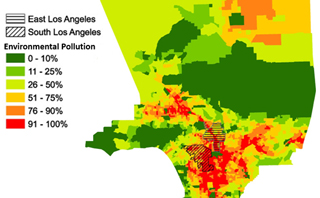
Participants lived primarily in South-Central Los Angeles or East Los Angeles communities, which experience a relatively high level of environmental pollution. (Image adapted from Kamai et al., 2023)
To advance public health, researchers and health practitioners must understand the lived experiences of the communities they serve, according to a study by the Maternal and Developmental Risks from Environmental and Social Stressors (MADRES) Center for Environmental Health Disparities in partnership with mothers living in Los Angeles County, California.
Led by Elizabeth Kamai, Ph.D., a postdoctoral fellow at the University of Southern California, the research team worked with community organizations to recruit and interview 36 pregnant Latina women and mothers of young children. The interviews explored the women’s perceptions of local environmental risks, preventative actions, and information sources, among other topics.
Participants consistently mentioned foul odors, trash, and other filth as signs of local environmental hazards, as well as fear and uncertainty about how their surroundings could affect health. Some women also expressed concerns about how environmental exposures, such as smoke, smog, and chemicals with strong odors, during pregnancy may affect the health of the fetus.
The respondents showed interest in learning about how to protect their family’s well-being.
According to the authors, listening to and valuing local perspectives and knowledge, can help to inform strategies that reduce environmental hazards to protect the health of expectant mothers and young children.
To learn more, see the NIEHS Environmental Factor newsletter.


